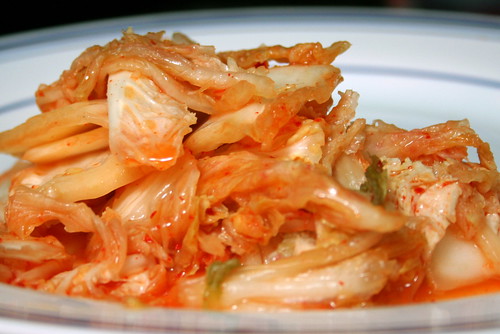Thursday, April 14, 2011
Garlic infused pork tenderloin
Thursday, April 7, 2011
Korean Cabbage - Kimchi

I was at a Korean restaurant a while ago and was served a delightful array of salad-looking appetizers with the soup I had ordered. My friend told me it was called kimchi. It was so delicious, I bought some from the store in the back of the restaurant.
The next thing I knew, my kimchi supply was gone. I had to do something, and because I enjoy trying to prepare new things, I thought I'd give kimchi a try. I found a recipe online to start with. The first batch was OK, but it was missing some things.
Over time, I started to figure out what was missing or what I had too much of. Aided by the palate of a Korean-American co-worker of mine (whose mom makes this stuff like it's going out of style), I believe I'm on my way to being accepted with open arms into Korean culture.
Now you can be too.
Ingredients
- 1 medium to large napa cabbage (about the size of a football)
- about 1/4 cup salt (and a bit extra for a brine)
- 1/4 cup red pepper flakes (NOT crushed red pepper powder)*
- 1 tbsp minced garlic
- 1 tbsp minced ginger
- about 5 green onions
- 1 tbsp fish sauce (totally optional)
- about 1/8 cup sugar
Directions
- Chop the cabbage into pieces a bit larger than bite size. By the end, they will have shrunk. Use the whole thing. Place it all in a large bowl, with enough room to toss it.
- Dissolve some salt in a bowl of warm water. Pour over the cabbage and toss so that everything gets wet. Let sit at room temperature for about four hours.
- After your cabbage has reduced, wash it well.
- Mix the red pepper flakes with about 1/4 cup warm water. It should be pasty, not runny. Add the paste to the cabbage.
- Add the garlic, ginger, green onions, and sugar. The sugar helps the fermentation process. Your kimchi should not taste sweet in the end, so use some judgment on exactly how much sugar you use. If you’re using fish sauce, add it now too.
- Toss the mixture. Hands work best, but be careful. If you’ve got plastic gloves, use them. I learned the hard way that even if I think your hands are clean, hours later it still could burn my eyes.
- After it’s all mixed, bottle it up. I have a huge pickle jar I use, but several smaller ones will suffice. You should get a pretty substantial amount of kimchi out of this recipe. Close them up well and leave them out at room temperature for 24 hours to ferment.
Come on back after a while and let me know how you liked it!
Saturday, January 1, 2011
The Challenge ...
This time will be different! This time I have a plan! This time, I have no choice since I just said that it will be different :). In all seriousness, I do have a plan of action this time around and I believe that the process will motivate me enough to keep up with it and keep this blog alive as long as I can.
This blog is about me wanting to cook my way through the world's recipes and saving money along the way. My philosophy is that good food does not have to cost you an arm and a leg; good food is about traditions, good-fresh ingredients, and what you do with those ingredients. It really upsets me when I have to pay $25 for a plate of "Italian" pasta at some wannabe high-end Italian Bistro (you know who you are), when I know that the same pasta dish would be considered as "peasant" or an everyday meal to some real Italian family. It pisses me off even more when that pasta dish sucks and I know full well that I can make it better, and less expensive.
Why foods from around the world? Why not? I get so bore with eating and cooking the same thing, it's time to broaden the horizon a bit. Besides, I'm very curious to see what other regions of the world have to offer to us in terms of foods. There has to be more to Indian cooking than "curry" or what we believe is "curry". What about Mexican cuisines? Did you know that nachos is an American invention? I'm interested in digging deeper to find the foods that we would considered as "homemade" or "grandma's cooking", foods that we would love to eat when it's cold outside, and chicken noodle soup just won't cut it anymore.
So here's what I'm going to do and how I'll do it:
The challenge: To cook and experiment with foods from all regions of the world on a frugal budget ($50 a week).
The purpose: To save $$ while eating well, and maybe learn a trick or two along the way.
Time frame: 1 year. I work well when there's an end date, even if that end date is flexible.
The end result: Hopefully a well-rounded collection of recipes from all over world, and some extra cash in my savings (these are hard times you know).
This weekend I will gather some recipes and do a little shopping (have to get started on my Christmas list as well); the next post will be my first step into a new (and frugal) culinary journey. Can't wait to start ...
